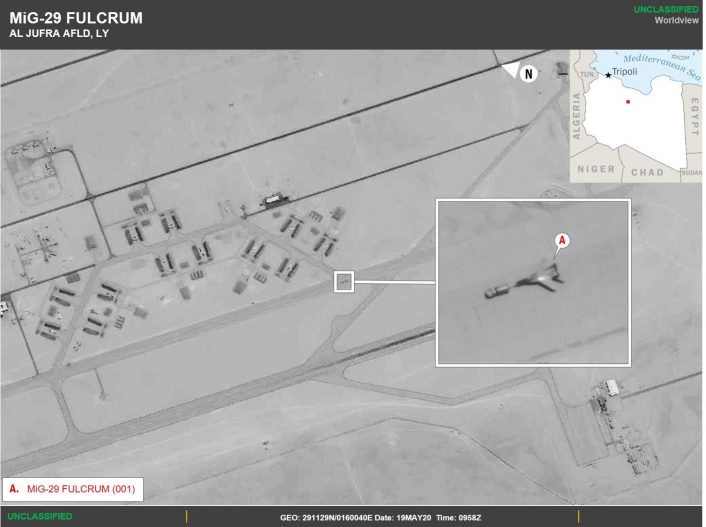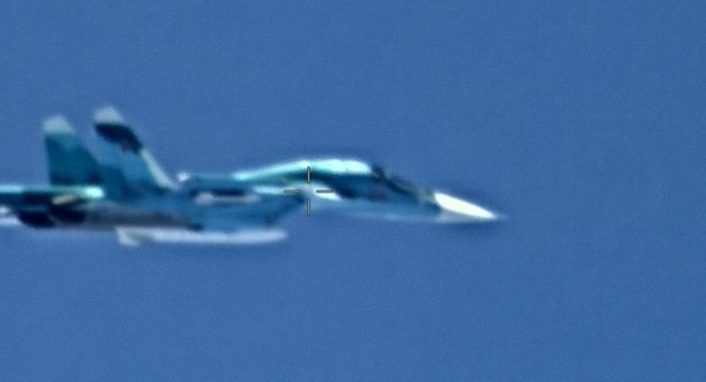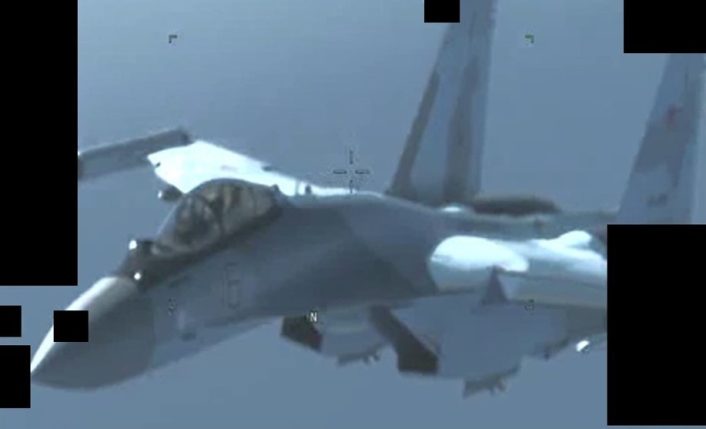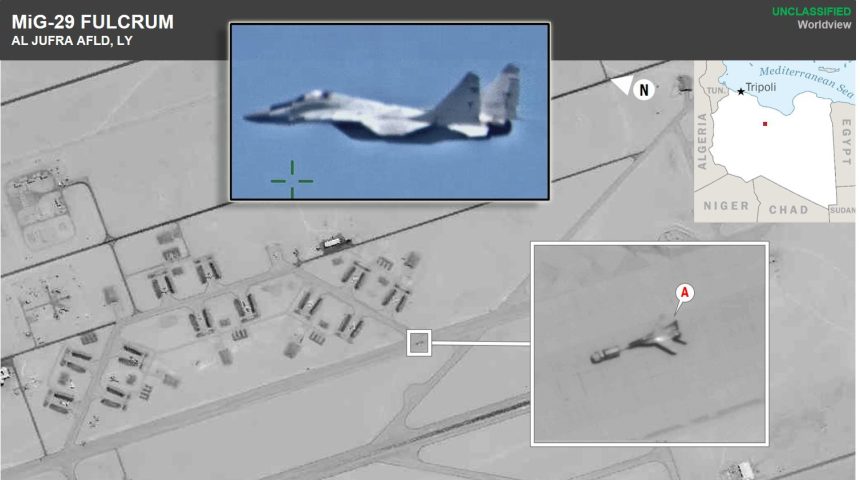Satellite imagery had already showned at least one MiG-29 on the ground in Libya. The U.S. Africa Command has just released some additional details and images.
Last week we reported about the alleged deployment to Libya of a certain number of MiG-29s and Su-24s to support Haftar’s Libyan National Army forces in the war against Fajez Serraj and his Government of National Accord. The arrival of the contingent of MiG-29s and accompanying Su-24s was announced by GNA’s Ministry of Interior Fathi Bashagha who told Bloomberg that the aircraft had been “escorted by two Russian Air Force Su-35s” a claim that seemed quite unlikely, considered that, thus far, Russia has not officially taken part in the conflict in Libya.
As explained in the updated story posted on May 21, a satellite image showing one MiG-29 being towed at Al Jufra Air Base confirmed the presence of at least one Fulcrum in Libya. However, no signs of additional Fulcrums could be spotted thereafter:
MiG-29s in Libya update: I have checked hi-resolution satellite imagery from the last week of nearly every airport in Haftar’s territory, including Al Jufrah Air Base, where the one Fulcrum was spotted in a sat image. No signs of any MiG-29s or major logistical operations..1/X
— Tyler Rogoway (@Aviation_Intel) May 23, 2020
Interestingly, other shots pointed to another airbase, al-Khadim, in the east of Libya, as the possible destination for the Su-24 Fencer.
four birds too large to fit into these tiny shelters at al-Khadim airbase https://t.co/LLDGl2NS0k Su-24? (24 May 2020) pic.twitter.com/s0oxYPxNbf
— Samir (@obretix) May 25, 2020
Eventually, the first official confirmation of the deployment arrived on May 26, 2020, when U.S. AFRICOM (Africa Command) released a statement about the deployment titled “Russia deploys military fighter aircraft to Libya” (highlights mine):
U.S. Africa Command assesses that Moscow recently deployed military fighter aircraft to Libya in order to support Russian state-sponsored private military contractors (PMCs) operating on the ground there.
Russian military aircraft are likely to provide close air support and offensive fires for the Wagner Group PMC that is supporting the Libyan National Army’s (LNA) fight against the internationally recognized Government of National Accord. The Russian fighter aircraft arrived in Libya, from an airbase in Russia, after transiting Syria where it is assessed they were repainted to camouflage their Russian origin.
“Russia is clearly trying to tip the scales in its favor in Libya. Just like I saw them doing in Syria, they are expanding their military footprint in Africa using government-supported mercenary groups like Wagner,” said U.S. Army Gen. Stephen Townsend, commander, U.S. Africa Command. “For too long, Russia has denied the full extent of its involvement in the ongoing Libyan conflict. Well, there is no denying it now. We watched as Russia flew fourth generation jet fighters to Libya — every step of the way. Neither the LNA nor private military companies can arm, operate and sustain these fighters without state support — support they are getting from Russia.”
Russia has employed state-sponsored Wagner in Libya to conceal its direct role and to afford Moscow plausible deniability of its malign actions. U.S. Africa Command assesses Moscow’s military actions have prolonged the Libyan conflict and exacerbated casualties and human suffering on both sides.
“The world heard Mr. Haftar declare he was about to unleash a new air campaign. That will be Russian mercenary pilots flying Russian-supplied aircraft to bomb Libyans,” Townsend said.
U.S. Africa Command assesses that Russia is not interested in what is best for the Libyan people but are working to achieve their own strategic goals instead.
“If Russia seizes basing on Libya’s coast, the next logical step is they deploy permanent long-range anti-access area denial (A2AD) capabilities,” said U.S. Air Force Gen. Jeff Harrigian, commander, U.S. Air Forces in Europe-Air Forces Africa. “If that day comes, it will create very real security concerns on Europe’s southern flank.”
Russia’s destabilizing actions in Libya will also exacerbate the regional instability that has driven the migration crisis affecting Europe.
The statement was released along with the satellite image of the MiG-29 at Al Jufra airbase.

Noteworthy, along with the satellite shot, AFRICOM has also released a series of photographs and stills of Russian fighter jets, including MiG-29s, Su-34s and Su-35s, shot by spyplanes or drones’ EO/IR sensors or targeting pods. It’s not clear whether all of these were taken near Libya or are related to the deployment: there are types that are not believed to be involved in the deployment. Moreover, some show their original Red Star on the tail, while AFRICOM has confirmed the MiG-29s “were repainted to camouflage their Russian origin.”

A MiG-29 (Image credit: US AFRICOM)


Dealing with the role the aircraft can play in Libya here’s what this Author has written in hte previous article on this topic, after axplaining that the Russian jets have been deployed to back Haftar’s forces, already supported by the UAE, Egypt and Russian mercenaries in the war to take the control Tripoli launched last year.
Since November 2019, the government of Tripoli has been able to reject the attacks from Haftar’s LNA forces, taking also control of the strategic al-Watiya Air Base, 90 miles south of Tripoli. In other words, with the help of the Turkish drones and anti-aircraft systems the GNA has been able to achieve the air superiority in Tripolitania: in the last hours alone, Turkish UAVs have destroyed at least nine Russian “Pantsir” anti-aircraft systems, supplied by UAE to Haftar to protect LNA bases.
What role the MiGs and Sukhois would play in this war is hard to say: while the Su-24s are attack aircraft, the MiG-29s can theoretically be used to carry out counter-UAVs as well as air-to-surface missions. In other words, they may represent a deterrent for Turkish drones that have been used with devastating results by the GNA. However, at the same time, dispatching MiG-29s (flown by mercenaries) in contested airspace with still significant SAM (Surface Air Missile) and MANPADS (Man Portable Air Defense System) threat would expose the fighters to the risk of being targeted, and downed, as happened to other Libya National Army Air Force jets in the skies over Libya’s capital. Anyway, we will see.










